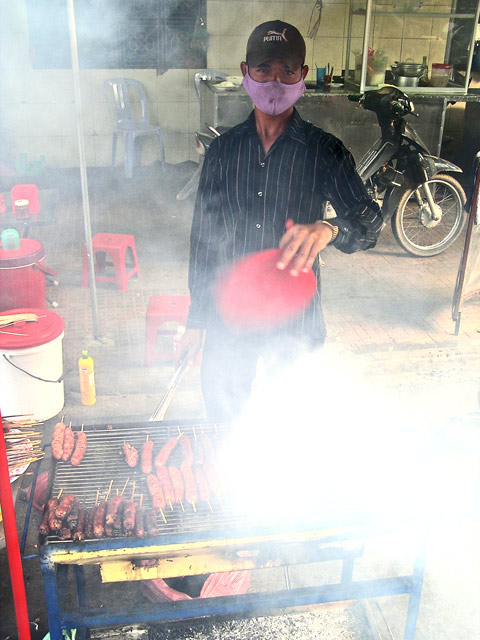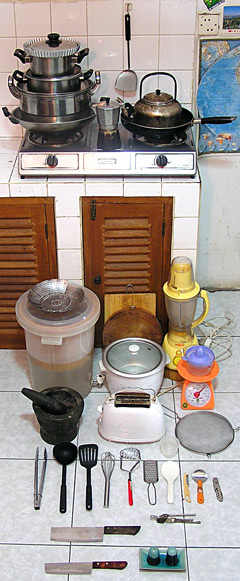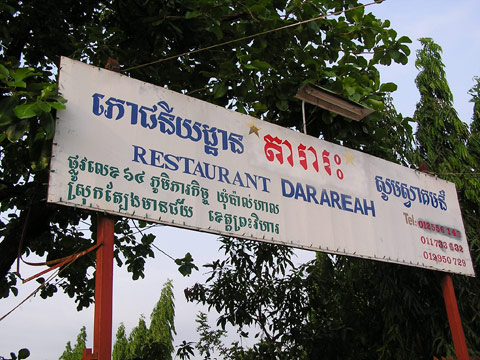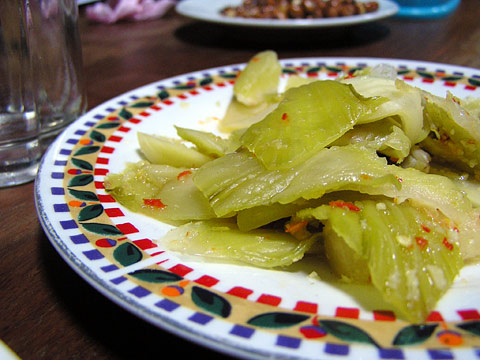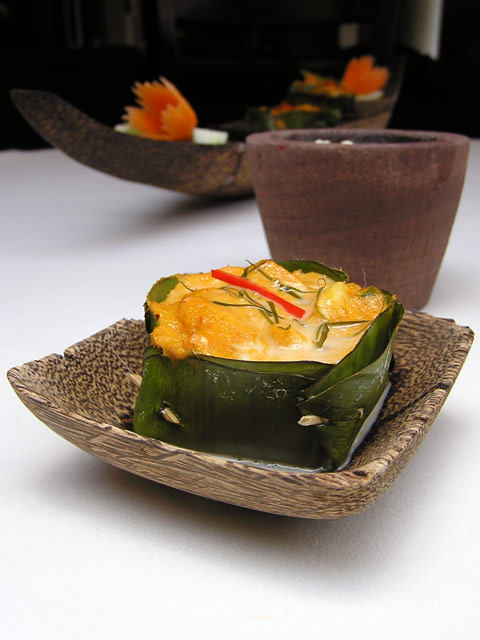Reader quiz: what the hell is the above vendor doing? And does he get to lick his arms afterwards?
Month: June 2007
Will Cambodian food catch on in NYC?
In short, no.
In New York, transplanted Hong Kong hands have a couple of Chinatowns to choose from. Colombians can head out to Queens for an oblea caramel wafer and yucca bread under the elevated train tracks. Eastern Europeans longing for a borscht can ride the F train to Brighton Beach. West Africans have the Bronx, North Africans have the East Village — and even the Uighurs, the Sephardim of the Silk Road, can find home cooking out in Rego Park. But for Cambodians (and nostalgic travelers like me), a taste of home remains elusive.
Matthew Fishbane attempts to answer the eternal question about Cambodian food: why isn’t it anywhere apart from Cambodia? He answers with a good round-up of the trials and tribulations of Cambodian restauranteurs in the USA.
See also: Khmer food is good, you just suck at eating it, On the trail of Cambodian food in New York
Reports of my fiery death slightly exaggerated
Thanks for emailing about the plane crash near Kampot, but thankfully, I was not involved in it. I’m too cheap to fly between Sihanoukville and Siem Reap.
I made it to Kampot safely and my only risk now is a fatal crab-and-pepper overdose.
Dirty street charcuterie
Cambodians are world champion charcutiers. What the locals lack in quality produce, they make up for in sheer volume and world-beating determination. A Cambodian household that doesn’t dry its own fish, meat scraps or leftover rice is rarer than one that doesn’t enjoy the sublime beauty of prahok. Everybody knows how to sun-dry their own ingredients: probably the best way to spot a non-Cambodian household is to pick the one without a tray of leftovers soaking up the sunlight at the front of the house. It’s a response to the seasonal nature of Cambodian food. The frequent boom and bust cycles of local agriculture and fisheries have forced everyone to develop a taste (and huge amounts of skill) for preserving everything that they can eat.
The Cambodian sausage is much maligned. It’s palm sugar-sweet, composed of half pork gristle and half pork fat, sometimes a touch of chilli for color, sold grilled on the dirtiest streets imaginable. They are inspired by Chinese sausages (laap cheong(?)) but will also be sold as small ball-shaped sausages as well as the more recognisable links. Vendors make their own links which they hang from a clothes rack to semi-dry before barbequing over hot coals. While hanging, the sausages pick up a little of the smoke-flavour from their charring compatriots as well as a good deal of dust from the road. Of all Cambodia’s streetside foods not deliberately involving fermentation, this is the one that I approach with the most trepidation.
The above sausage was served on a stick; a one-handed food in the parlance of modern convenience cuisine. More often than not, it is plated up with a basic pickle of shredded green papaya, carrot and vinegar that slices through the sausages’ sweetness and fattiness.
Location: Near Psar Chas, Phnom Penh. 500 riel per stick.
On the road again
I’m on the road with Austin from RealThai, visiting all the food hotspots in Cambodia that begin with the letter “S”: Siem Reap, Snoul, Skuon and Sre Ambel. As such, things are going to be a little slow at Phnomenon for a few days. I suggest catching up on some great food bloggers from the 1800s:
- The Art of Dining; or Gastronomy and Gastronomers by Abraham Heyward (1852) – The Derby Reporter says “No Housekeeper ought to be without this book, which is adapted to every class of society, the rich, the middle classes and the poor”.
- The Physiology of Taste by Jean Anthelme Brillat-Savarin (1842) – Anyone famous enough to have a cheese named after them as well as having the temerity to say “a dessert without cheese is like a beautiful woman who has lost an eye.” is worth a read.
As full as an egg
Thy head is as full of quarrels as an egg is full of meat, and yet thy head hath been beaten as addle as an egg for quarreling.
So says Mercutio, regarding the “Egg Man” debate currently raging in The Cambodia Daily letters page. For those of you playing at home, Phnom Penh’s aural landscape is punctuated by motorcyclists with a cartful of eggs and a loudspeaker that intones the looped words “PORNG MOAN AING PSOUM KROUENG PISEH” (Barbecued eggs with special sauce!). He’s up there with my favorite street vendor sounds: not as good as the Lambada-obsessed icecream vendor but more entertaining that the bread delivery guy who yells “nuuuuuum pan” (Breeeead!).
A few days ago the Cambodia Daily published a letter from an incensed expat, disturbed at 9am by an Egg Man’s call. This followed with an outpouring of support for the Egg Men, along with a follow up from the original writer pointing out that Phnom Penh has banned mobile loudspeakers. Essentially this is as good as local coverage of street food gets.
John from Jinja follows up with an interview with the Egg Man.
The minimal kitchen: A rare victory over acquisitiveness
One of the horrors of leaving your home for a foreign country is leaving a life’s worth of accumulation behind. One of the joys of arriving is accumulating anew and realising that a huge amount of what you’ve previously accumulated is ephemera. Left is a photo of the entirety of my current cookware in Cambodia. Most of it is so cheap, it’s practically disposable but in accumulating anew, I’ve pared the kitchen back to what I consider to be the bare essentials. When you have the rare chance to populate your kitchen with tools in a single hit, you tend to focus on the utilitarian rather than the meretricious.
Only two items are particularly Cambodian. The opaque bucket on the left is a cheap ceramic filter (locally marketed as ‘Rabbit Filter’) which lets you enjoy the fresh, cholera-free flavour of Phnom Penh tap water without the risk of death. Between the vegetable peeler and the waiter’s friend on the right is a tool to shred green papaya and green mango. The other local element is the quality of the appliances – the combined purchase price of the pictured rice cooker and blender is not more than $30 : and so it is within reason that they’ll catch fire at an inopportune moment.
Omitted are our set of knives – a full block of Victorinox knives, a single 20cm chef’s knife, and sharpening steel : they were returned to Australia on our last trip in preparation for leaving Cambodia. My predilection for travelling with carry-on luggage only and the airlines’ aversion to knife-toting passengers are a poor mismatch. I also couldn’t find the bread knife when I took the photo. The remaining knives are the Thai Kiwi-brand cleaver and mini cleaver: these are the tools that I’ve seen locals do everything from gut pigs to carve fruit with, and so they’ll suffice for the next few months.
Also missing is the bakeware and turbo oven, a mini convection oven that is a remarkably good oven analogue for a machine that looks like a glass basin attached to a hairdryer. I’ve recently discovered that the ‘defrost’ setting cooks at just above 60oC which is perfect for toying with meat in a manner that would make Hervé This proud.
While it will be heart-rending to part with the 1960s yellow glass dinner set that I methodically collected through a decade of thrift shop trawling and the Mexican iron tortilla press, I can do without much of the kitchen junk that I have in storage. And disposing of it gives me an excuse to acquire again.
Cambodian wedding food in Tbaeng Meanchey
I’ve been reticent about reviewing Cambodian wedding cuisine because regardless of how tenuous my link is to the happy couple, I’m still wary of reviewing private events lest friends stop inviting me to their houses to sample their attempts at cooking and imbibe their booze. If you spend any length of time in Cambodia, you’ll attend a wedding. They tend to be massive affairs held either in the gargantuan reception warehouses dotted around Phnom Penh or in a tent in the middle of the street, in front of a relative’s house. Knowing the bride or groom is not a prerequisite to being invited.
Cambodian wedding food constitutes a whole genre of its own and much like the wedding ceremony, it tends to draw on an array of foreign influences. In Phnom Penh, it’s not uncommon to have a Western-style, towering wedding cake, Thai tom yam soup, Chinese stir frys and a bottle of imported whiskey all at the same meal. Regardless of the food, the format of the meal is prescribed: set tables of ten (or eight in Sihanoukville*) are served as soon as they are seated. If your group is smaller than ten, random strangers will join your table or else you can join theirs as food will not be served until your table is full.
First comes a set of pickles and amusé (for lack of a better word), which in the past has included steamed pigs’ ears, cashew nuts, pickled vegetables, spring rolls, faux meats, and once, slices of Spam. A soup and a few mains follow that are shared by the whole table. The mains depend on the budget of the wedding, ranging from langoustine or whole steamed fish to stir-fried offal.
When I was in Tbaeng Meanchey in Cambodia’s north for a night, the only restaurant in town, Darareah, was booked out for a wedding. So instead of harassing the overstretched kitchen into cooking us something else, we ordered the wedding food.
These were some of the best Cambodian pickles I’ve ever eaten. Very simple garlic, chilli and mustard-y green. This far north in Cambodia, there is more of a preference for chilli-hot foods and the liberal use of chilli serves this pickle no disrespect.

Round 2: Stir-fried mixed vegetables with rehydrated pork skin.
The purpose of rehydrated pork skin is a mystery. After it is removed from the pig, the skin is deep-fried into thin sheets and then rehydrated when the mood takes you. It adds practically no pork flavour to anything and tends to lurk at the bottom of Cambodian soups and stir-frys, surprising diners with the mouthfeel equivalent of stepping on a beached jellyfish. Cauliflower turns up in the strangest parts of Cambodia and this place is no stranger.
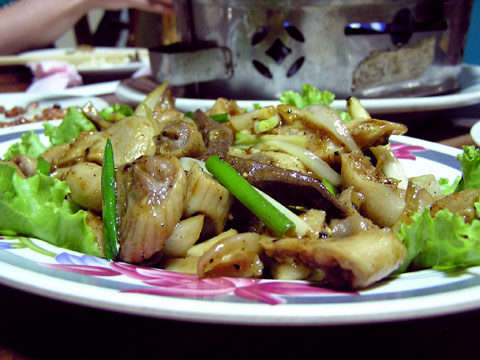
Round 3: Stir-fried pipes with pepper and sugar
Sweet, sweet offal candy! Along with watery sour soup and stirfried morning glory, this dish is one of the staples of Cambodian village travel. I’m not sure what one of the parts in this intestine stir-fry is, but I do know it comes from a pig. The other parts come from a pepper tree, sugar cane and the industrial glutamate factories of Ajinomoto.
The more time I spend travelling South East Asia, the more that I’m convinced that tom yam soup is becoming the South East Asian equivalent of pizza, a food that has become detached from its point of origin to become a regionally-specific genre of its own, for example Malaysian tom yam. This close to the Thai border however, Khmer tom yam is indistinguishable from Thai tom yam nam khon.
Location: Darareah Restaurant, next to the roundabout in Tbaeng Meanchey, Preah Vihear province. If you’re visiting the Preah Vihear ruins from the Cambodian side, you’ll inevitably eat there as dining options in the town are limited.
* – At an event with some coworkers in Sihanoukville, I asked why there were only eight seats per table in this province and ten in other provinces. ‘It’s lucky’ they answered. ‘It’s lucky because in Sihanoukville, we get to eat more food.’
Amokalypse Now: Gratuitous food porn edition
The above photo is the fish amok from Malis restaurant in Phnom Penh : the same amok that I shot for the Wall Street Journal article. I expected that they’d use this photo rather than the one that they did : this is about as well as I can capture gratuitous, selectively-focused food porn without resorting to either Adobe Photoshop or a full-time photographer. The only food styling that I performed was to place a paper napkin under the banana leaf to soak up some of the wayward coconut milk. Otherwise, this is the amok that Malis serves every day.
Location: Malis, Norodom Blvd, just south of the Independence Monument.
See Also: Real Khmer? Cambodian Fine Dining in Phnom Penh, Seeing how the other half lives – Malis and Pacharan
Cambodian food proverbs
If there is one thing that Cambodia loves more than its food, its a proverb. Maytel, over at Gut Feelings (where I also occasionally contribute non-Cambodian food jackassery) has unearthed a swathe of food-related proverbs. My favorite:
“The pig dies because it is meat”
See: Gut Feelings
